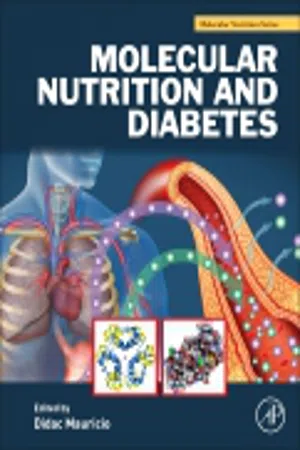
Molecular Nutrition and Diabetes
A Volume in the Molecular Nutrition Series
- 400 pages
- English
- ePUB (mobile friendly)
- Available on iOS & Android
About this book
Molecular Nutrition and Diabetes: A Volume in the Molecular Nutrition Series focuses on diabetes as a nutritional problem and its important metabolic consequences. Fuel metabolism and dietary supply all influence the outcome of diabetes, but understanding the pathogenesis of the diabetic process is a prelude to better nutritional control.Part One of the book provides general coverage of nutrition and diabetes in terms of dietary patterns, insulin resistance, and the glucose-insulin axis, while Part Two presents the molecular biology of diabetes and focuses on areas such as oxidative stress, mitochondrial function, insulin resistance, high-fat diets, nutriceuticals, and lipid accumulation. Final sections explore the genetic machinery behind diabetes and diabetic metabolism, including signaling pathways, gene expression, genome-wide association studies, and specific gene expression. While the main focus of each chapter is the basic and clinical research on diabetes as a nutritional problem, all chapters also end with a translational section on the implications for the nutritional control of diabetes.- Offers updated information and a perspective on important future developments to different professionals involved in the basic and clinical research on all major nutritional aspects of diabetes mellitus- Explores how nutritional factors are involved in the pathogenesis of both type1 and type2 diabetes and their complications- Investigates the molecular and genetic bases of diabetes and diabetic metabolism through the lens of a rapidly evolving field of molecular nutrition
Frequently asked questions
- Essential is ideal for learners and professionals who enjoy exploring a wide range of subjects. Access the Essential Library with 800,000+ trusted titles and best-sellers across business, personal growth, and the humanities. Includes unlimited reading time and Standard Read Aloud voice.
- Complete: Perfect for advanced learners and researchers needing full, unrestricted access. Unlock 1.4M+ books across hundreds of subjects, including academic and specialized titles. The Complete Plan also includes advanced features like Premium Read Aloud and Research Assistant.
Please note we cannot support devices running on iOS 13 and Android 7 or earlier. Learn more about using the app.
Information
Nutrition and Diabetes
General Aspects
Abstract
Keywords
Clinical nutrition; Diabetes management; Guidelines; HbA1c; History; Lipids; Macronutrient; Randomized controlled trials; Systematic review1. Introduction
2. Historical Perspective
Table of contents
- Cover image
- Title page
- Table of Contents
- Series Preface
- Copyright
- Dedication
- Contributors
- Preface
- Acknowledgments
- Section 1. General and Introductory Aspects
- Section 2. Molecular Biology of the Cell
- Section 3. Genetic Machinery and its Function
- Index